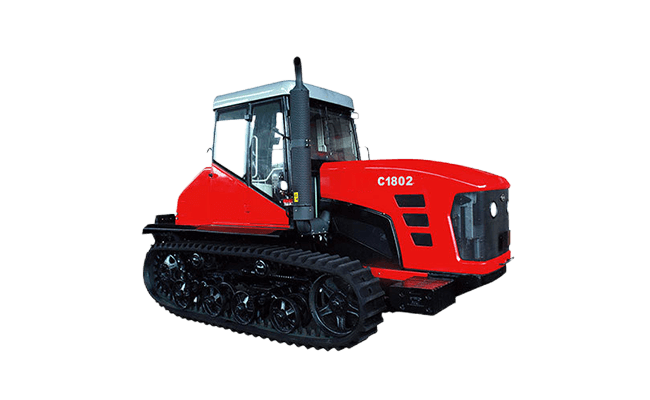In modern agriculture, the challenge of increasing efficiency while protecting soil has become a significant concern for every farmer. At this point, tracked tractors emerge as reliable partners. With their outstanding performance and flexible operational capabilities, they assist farmers in navigating their tasks with ease. Their introduction makes heavy agricultural work lighter and more efficient.
Tracked tractors feature a unique track design and a powerful powertrain, allowing them to operate effectively in complex terrains such as muddy fields and steep slopes. Their larger ground contact area not only reduces soil compaction, which helps ensure healthy crop growth, but also increases traction. This enhances stability and safety during operations. As a result, tracked tractors are ideal for large-scale agricultural production and precision farming.
Next, this article will explore the basic characteristics, main advantages, wide applications, and future development trends of tracked tractors. Let us uncover the mysteries of this powerful agricultural tool together.

Contents
- 1 Tracked Tractors: The Powerhouses of Agricultural Operations
- 2 Tracked Tractors: Unmatched Advantages
- 3 Wide Applications of Tracked Tractors in Agriculture
- 4 Maintenance and Care: Ensuring Long-Term Stable Operation
- 5 Economic Benefits of Crawler Tractors
- 6 Market Trends and Competitive Analysis
- 7 Training and Education
- 8 International Market and Export Opportunities
- 9 Environment and Sustainability
- 10 Conclusion
Tracked Tractors: The Powerhouses of Agricultural Operations
Tracked tractors stand out from traditional wheeled tractors due to their unique track design, showcasing several key features:
Outstanding Track Design
The innovative design of the tracks allows the tractor to move smoothly across complex terrains such as muddy fields, sandy soils, and slopes. The tracks effectively distribute weight, reducing ground pressure, which significantly decreases slippage and enhances operational stability. This design is particularly beneficial for working in harsh weather conditions, such as slippery fields after rainfall.
Robust Power System
Tracked tractors usually come equipped with high-powered engines that provide strong support during heavy-duty operations. For instance, certain models can tow heavy equipment weighing over 3,000 kilograms while plowing, ensuring efficient performance in various environments. This power configuration makes them especially popular on large-scale farms.
Increased Ground Contact Area
Compared to wheeled tractors, tracked tractors have a larger ground contact area, which effectively distributes pressure and minimizes soil compaction. This characteristic allows tracked tractors to maintain the natural structure and permeability of the soil during deep plowing or tilling. As a result, it helps improve soil fertility and promotes healthy crop growth.
Tracked Tractors: Unmatched Advantages
Exceptional Off-Road Performance
Tracked tractors excel on slippery or uneven surfaces, making them perfect for farming tasks in mountainous or hilly regions. They can easily access areas that traditional tractors cannot reach. Their outstanding traction ensures safe and efficient operations in complex terrains.
High Efficiency in Operations
With powerful engines and excellent stability, tracked tractors can cover large areas quickly during tilling and planting. For example, a tracked tractor can plow over 10 acres of land in just one hour, significantly boosting work efficiency and saving farmers time and labor costs.
Soil Health Protection
Tracked tractors exert relatively low ground pressure, effectively reducing soil compaction while maintaining soil permeability and structure. This characteristic not only supports root development but also enhances soil moisture retention, promoting healthy crop growth.
Versatile Operational Capabilities
Modern tracked tractors can perform various tasks by swapping different attachments, including tilling, planting, fertilizing, and harvesting. For instance, farmers can install both seeders and fertilizer spreaders on the same tractor, allowing for flexible operations that meet the diverse needs of different crops.
Strong Adaptability
Tracked tractors adapt well to various climate and soil conditions, making them ideal for large-scale agricultural production. Whether working in the arid western plains or the rainy eastern regions, tracked tractors consistently deliver exceptional performance.
Wide Applications of Tracked Tractors in Agriculture
The Best Choice for Rice Planting
In rice cultivation, tracked tractors effectively handle moisture in paddy fields, ensuring continuous and precise operations. Their design prevents sinking in wet soil, making them the preferred equipment in many rice-growing regions.
A Valuable Assistant in Orchards
Tracked tractors navigate easily between trees in orchards without compacting the soil, which supports the healthy growth of fruit trees. With versatile attachments, they can be used for fertilizing and spraying, improving orchard management efficiency. For instance, by adjusting the working depth, farmers can accurately control fertilizer application, enhancing fruit yield.
A Flexible Partner for Vegetable Cultivation
In vegetable farming, tracked tractors operate well in various soil conditions, suitable for different tilling and harvesting tasks. For example, in greenhouses, they can flexibly perform tasks such as planting, thinning, and harvesting, helping farmers efficiently manage a wide range of vegetable crops.
The New Favorite in Facility Agriculture
As facility agriculture develops, the use of tracked tractors in greenhouses and raised beds becomes increasingly common. Their precise operational capabilities ensure efficient work in limited spaces, meeting modern agriculture’s demand for high efficiency and multifunctionality in equipment.
Maintenance and Care: Ensuring Long-Term Stable Operation
Regular Inspections Are Crucial
Regularly check the wear of the tracks and replace or adjust them as needed to ensure optimal ground performance. It is advisable to inspect the tracks every month and adjust the maintenance plan based on usage.
Maintain the Lubrication System
Keep the lubrication system in good condition by regularly adding oil to reduce friction and wear, thus extending the machine’s lifespan. Special attention should be given to lubricating the power system and the track connections, as this can significantly lower the failure rate.
Cleaning Maintenance Is Essential
After operation, promptly clean the machine, especially the tracks and engine, to prevent dirt and debris from accumulating and affecting performance. Use a pressure washer and brush to ensure every component stays clean.
Regular Overhaul of the Power System
Periodically inspect the engine and power system to ensure they operate normally. It is recommended to perform a comprehensive inspection every 500 hours to address any issues promptly and avoid unexpected downtime during operations. Technological Innovations in Crawler Tractors
Application of New Materials
Modern agricultural machinery faces the dual challenge of durability and lightweight design. To address this, developers of crawler tractors have begun using lightweight, high-strength materials such as carbon fiber and aluminum alloy. These materials not only reduce the overall weight of the equipment, improving fuel efficiency, but also maintain outstanding durability in harsh environments. For instance, the use of carbon fiber helps the tracks stay stable on complex terrains, reducing wear and extending the tractor’s lifespan. This innovation provides farmers with a higher return on investment.
Intelligent Control Systems
As technology advances, intelligent control systems have become a standard feature in crawler tractors. The combination of automatic driving technology and crop recognition systems allows tractors to perform farming tasks with minimal human intervention and improved accuracy. This significantly boosts operational precision. For example, tractors equipped with sensors can monitor soil conditions in real-time and automatically adjust working parameters as needed, ensuring that each part of the field receives the best possible treatment.
Economic Benefits of Crawler Tractors
Cost-Effectiveness Analysis
The initial investment in a crawler tractor may be relatively high, but its long-term cost-effectiveness is clear. By increasing operational efficiency and reducing fuel consumption, this type of tractor helps farmers recover their investment over a few years. For example, during farming operations, a crawler tractor, with its efficient power system and stability, can complete double the work of a traditional tractor in the same amount of time. This significantly cuts down on labor and time costs.
Return on Investment
Studies show that farms using crawler tractors experience an average increase in crop yield of more than 20%. This improvement is not just limited to individual operations but is achieved through consistent efficient management and precise operations. For instance, in wheat and rice farming, farmers achieve better crop health and higher yields through accurate fertilization and seeding. This return on investment motivates more and more farmers to choose crawler tractors as their primary work tool.
Market Trends and Competitive Analysis
Changes in Market Demand
As global attention on agricultural efficiency and sustainability grows, the demand for crawler tractors continues to rise. This is especially true in emerging markets, where the push toward agricultural modernization makes crawler tractors an ideal choice for farmers seeking efficient operations. This trend drives manufacturers to innovate continuously to meet the evolving needs of the market.
Key Competitors
Major competing brands in the market, such as John Deere, Case, and New Holland, have each launched their own competitive products in the crawler tractor sector. These brands attract a large customer base through ongoing technological innovation and strategic marketing efforts. For example, one of John Deere’s crawler tractor models is highly popular due to its high efficiency and eco-friendly design. By comparing the product features of these competitors, potential buyers can make more informed decisions.
Training and Education
Need for Operational Training
As the technology behind crawler tractors becomes more advanced, the need for training farmers and operators has become increasingly important. Many manufacturers now offer specialized training programs to help users develop efficient and safe operating skills. For example, the training covers essential topics such as basic tractor maintenance, the use of intelligent systems, and troubleshooting. This ensures that users can fully maximize the potential of their equipment.
International Market and Export Opportunities
Global Market Potential
With the acceleration of agricultural globalization, the potential for crawler tractors in the international market is becoming increasingly evident. In emerging markets such as South America, Southeast Asia, and Africa, the demand for crawler tractors is rising as the level of agricultural mechanization improves. Many Chinese manufacturers are actively expanding into these markets, striving to secure a place in the global competition.
Export Policies and Challenges
Despite the numerous opportunities in the international market, exporting Chinese crawler tractors faces several challenges. For instance, different countries have varying technical standards and environmental requirements for agricultural machinery. Companies must continuously adjust their products to meet these regulations. Moreover, competition in the global market is fierce, so businesses need to enhance product quality, after-sales service, and brand influence to secure a larger market share.
Environment and Sustainability
Sustainable Agricultural Development
Crawler tractors play a key role in promoting sustainable agricultural development. Their design effectively reduces soil erosion, preserving the structure and fertility of the soil. During deep plowing and fertilizing, these machines minimize environmental impact, providing farmers with a more sustainable way to manage their fields.
Carbon Footprint and Eco-Friendly Practices
With growing global attention on climate change, the carbon footprint of agricultural machinery has become a major topic of discussion. Manufacturers of crawler tractors are working to develop low-emission, fuel-efficient equipment to reduce the environmental impact of agricultural production. For example, some new crawler tractors use hybrid power systems, significantly cutting emissions during operation, thus supporting sustainable agriculture.
Conclusion
Crawler tractors, with their unique design and excellent performance, are leading an agricultural revolution. They not only improve operational efficiency but also reduce soil compaction and perform steadily in various challenging environments. As technology continues to advance and market demands evolve, the future of crawler tractors looks even more promising. By promoting sustainable agricultural development and increasing productivity, crawler tractors create greater value for farmers and help drive the growth of modern agriculture. If you have more questions about crawler tractors, feel free to visit our website. Together, let’s move toward a brighter future in agriculture!

